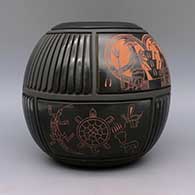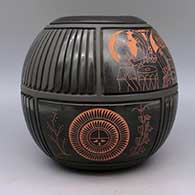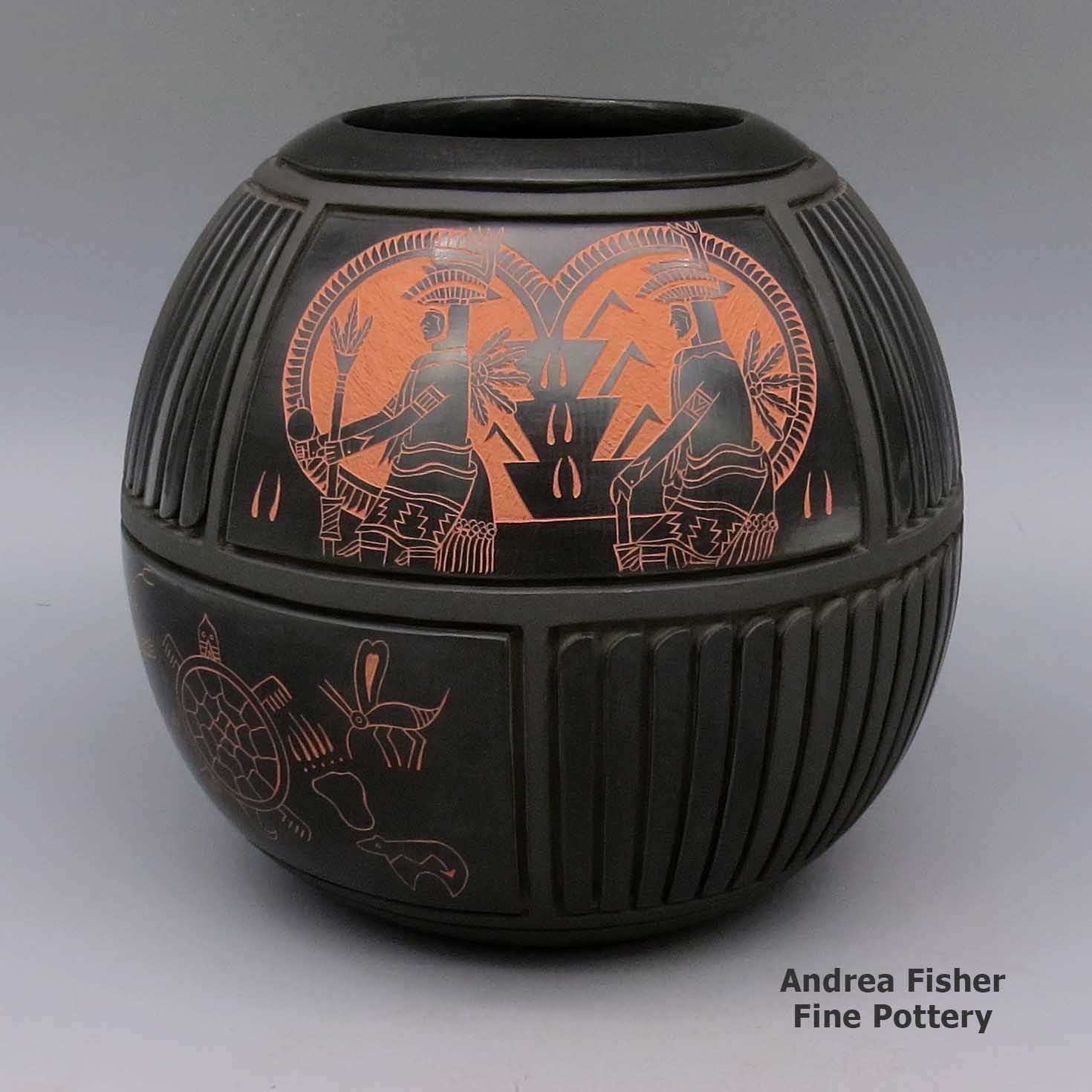
Ohkay Owingeh
$ 4200
plsj2k144
Black and red jar with carved feather geometric design and sgraffito dancer, sun face, turtle, lizard, insect, bear with heart line, and bear paw design
8.25 in L by 8.25 in W by 7.75 in H
Condition: Very good
Signature: Tom and Sue Tapia San Juan Pue. NM
Sale Price: $3000
Tell me more! Buy this piece!
(505) 986-1234 - www.andreafisherpottery.com - All Rights Reserved
Tom Tapia
Ohkay Owingeh(San Juan)
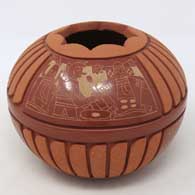
"I was told at one time that I was given this talent not to gain fame, but as a means of making a living."
Tom Tapia was born into Ohkay Owingeh in May 1946. He was the son of Jose B. Tapia and Leonidas Cata Tapia. He was born and raised in Los Alamos, NM, but his parents always kept him active in religious and cultural activities at Ohkay Owingeh. His mother also made Potsuwi'i-style pottery and Tom learned how to make that from watching and working with her.
When Tom married Sue Tapia of Laguna Pueblo, she moved to his home at Ohkay Owingeh and learned to make Potsuwi'i-style pottery, too. However, she was from Laguna and there were problems about her using Ohkay Owingeh styles and designs, so Tom innovated his own offshoots and added sgraffito to his design toolkit.
Tom would usually design the pots that Sue would make. Then Tom would decorate some and Sue would decorate others. Often they'd collaborate, and Sue's deep carving mixed with Tom's sgraffito design work earned them multiple awards. Then Tom died in 2015 and shortly after, Sue moved back to Laguna.
Sue Tapia
Laguna/San Juan
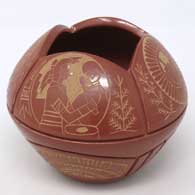
"Each piece of pottery has within it a part of their heart and soul because, traditionally, that's what it takes to work with the gifts that The Mother has so generously provided."
Sue Tapia was born to Edward Poncho Sr. and Mabel Poncho of Laguna Pueblo in May 1946. That was a time when most Laguna men had good-paying jobs and the women were essentially free to do whatever with their time. Mabel had learned to make pottery from her mother and in the early and mid 1950s, often went with her mother to sell pottery along the side of Route 66 as it wound its way across Laguna Pueblo. But Mabel made little pottery for commercial purposes, most of her pottery was for ceremonial use only. That's what Sue learned to make as she was growing up. Then she married Tom Tapia and moved to his home at San Juan Pueblo.
At San Juan, Sue learned to make Potsuwi'i pottery. Tom had grown up learning the traditional methods for making Potsuwi'i pottery with his mother, Leonidas Tapia. Then after marrying Sue, he deviated from that and added sgraffito to his toolkit.
Their process evolved to where Tom designed the pots that Sue made. Then he would decorate some and she would decorate some. They earned many awards over the years at venues like the Gallup InterTribal Ceremonial, the Eight Northern Indian Pueblos Arts & Crafts Show and the New Mexico State Fair.
Tom passed on in 2015 and shortly after, Sue returned to Laguna Pueblo.
Ohkay Owingeh (San Juan)
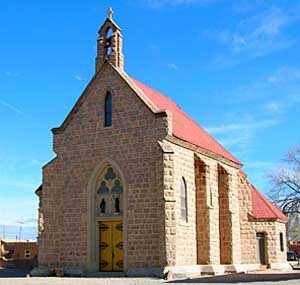
Ohkay Owingeh Mission
In 2005 San Juan Pueblo officially changed its name back to the original name (before the Spanish arrived): Ohkay Owingeh (meaning: Place of the strong people). The pueblo was founded around 1200 AD during the time of the great Southwest drought and migrations. The people speak Tewa and may have come to the Rio Grande area from southwestern Colorado or from the San Luis Valley in central Colorado.
Spanish conquistador Don Juan de Oñate took control of the pueblo in 1598, renaming it San Juan de los Caballeros (after his patron saint, John the Baptist). He established the first Spanish capitol of Nuevo Mexico across the Rio Grande in an area he named San Gabriel. In 1608, the capitol was moved south to an uninhabited area that became the Santa Fe we know today.
After 80 years of progressively deteriorating living conditions under the Spanish, the tribe participated in the Pueblo Revolt of 1680 (one of the revolt's ringleaders, Popé, was an Ohkay Owingeh native) and helped to expel the Spanish from Nuevo Mexico for 12 years. However, when the Spanish returned in 1692 that tribal unity had fallen apart and the individual pueblos were relatively easy for the Spanish to reconquer.
Today, Ohkay Owingeh is the largest Tewa-speaking pueblo (in population and land) but few of the younger generations are interested in carrying on with many of the tribe's traditional arts and crafts (such as the making of pottery). The pueblo is home to the Eight Northern Indian Pueblos Council, the Oke-Oweenge Arts Cooperative, the San Juan Lakes Recreation Area and the Ohkay Casino & Resort. The tribe's Tsay Corporation is one of northern New Mexico's largest private employers.
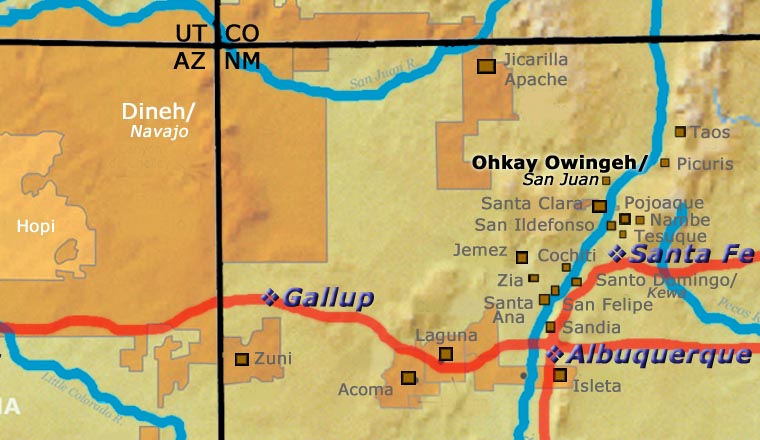
Ohkay Owingeh at Wikipedia
Pueblos of the Rio Grande, Daniel Gibson, ISBN-13:978-1-887896-26-9, Rio Nuevo Publishers, 2001
Tapia Family Tree
Disclaimer: This "family tree" is a best effort on our part to determine who the potters are in this family and arrange them in a generational order. The general information available is questionable so we have tried to show each of these diagrams to living members of each family to get their input and approval, too. This diagram is subject to change should we get better info.
- Leonidas Cata Tapia (d. 1977) & Joe Blas Tapia
- Tom Tapia (1946-2015) & Sue Tapia (Laguna)(1945-)
- Matt Valencia & Ida Francisco
- Justin Valencia
- Patrick Valencia
- Matt Valencia & Ida Francisco
- Mary Trujillo (1937-2021) & Leonard Trujillo (1936-2017)(Cochiti)(son of Helen Cordero)
Some of the above info is drawn from Pueblo Indian Pottery, 750 Artist Biographies, by Gregory Schaaf, © 2000, Center for Indigenous Arts & Studies
Other info is derived from personal contacts with family members and through interminable searches of the Internet.
Copyright © 1998-2024 by


